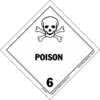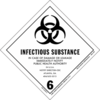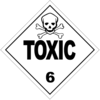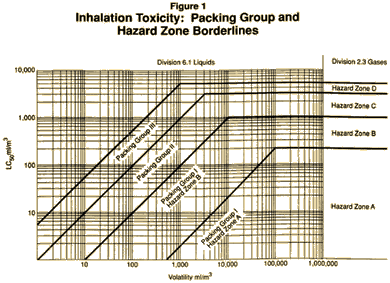HAZMAT Class 6 Toxic and infectious substances
Poisonous material is a material, other than a gas, known to be so toxic to humans that it presents a health hazard during transportation
Divisions
Division 6.1: Poisonous material is a material, other than a gas, which is known to be so toxic to humans as to afford a hazard to health during transportation, or which, in the absence of adequate data on human toxicity:
- Is presumed to be toxic to humans because it falls within any one of the following categories when tested on laboratory animals (whenever possible, animal test data that has been reported in the chemical literature should be used):
- Oral Toxicity: A liquid with an LD50 for acute oral toxicity of not more than 500 mg/kg or a solid with an LD50 for acute oral toxicity of not more than 200 mg/kg.
- Dermal Toxicity. A material with an LD50 for acute dermal toxicity of not more than 1000 mg/kg.
- Inhalation Toxicity: A dust or mist with an LC50 for acute toxicity on inhalation of not more than 10 mg/L; or a material with a saturated vapor concentration in air at 20 °C (68 °F) of more than one-fifth of the LC50 for acute toxicity on inhalation of vapors and with an LC50 for acute toxicity on inhalation of vapors of not more than 5000 ml/m³; or
- Is an irritating material, with properties similar to tear gas, which causes extreme irritation, especially in confined spaces.
Division 6.2: Biohazards.
Placards
 |
Hazardous Materials |
| Class 6.1: Poison |
|
 |
Hazardous Materials |
| Class 6.2: Biohazard |
|
 |
Hazardous Materials |
| Class 6: Packing Group III |
|
 |
Hazardous Materials |
| Class 6: Toxic |
|
- Poison: 454 kg (1001 lb) or more gross weight of poisonous materials that are not in Hazard Zone A or B (see Assignment of packing groups and hazard zones below).
- Inhalation Hazard: Any quantity of a material that is in Hazard Zone A or B (see Assignment of packing groups and hazard zones below).
- Toxic: May be used instead of POISON placard on 454 kg (1001 lb) or more gross weight of poisonous materials that are not in Hazard Zone A or B (see Assignment of packing groups and hazard zones below).
- PG III (Packing Group III): May be used instead of POISON placard on 454 kg (1001 lb) or more gross weight of Poison PG III materials (see Assignment of packing groups and hazard zones below).
Lethality
Lethal Dose 50
- Oral Toxicity: LD50 for acute oral toxicity means that dose of the material administered to both male and female young adult albino rats which causes death within 14 days in half the animals tested. The number of animals tested must be sufficient to give statistically valid results and be in conformity with good pharmacological practices. The result is expressed in mg/kg body mass.
- Dermal Toxicity: LD50 for acute dermal toxicity means that dose of the material which, administered by continuous contact for 24 hours with the shaved intact skin (avoiding abrading) of an albino rabbit, causes death within 14 days in half of the animals tested. The number of animals tested must be sufficient to give statistically valid results and be in conformity with good pharmacological practices. The result is expressed in mg/kg body mass.
| Determining Acute LD50 |
For purposes of classifying and assigning packing groups to mixtures possessing oral or dermal toxicity hazards according to the criteria in 49CFR 173.133(a)(1), it is necessary to determine the acute LD50 of the mixture. If a mixture contains more than one active constituent, one of the following methods may be used to determine the oral or dermal LD50 of the mixture:
- Obtain reliable acute oral and dermal toxicity data on the actual mixture to be transported;
- If reliable, accurate data is not available, classify the formulation according to the most hazardous constituent of the mixture as if that constituent were present in the same concentration as the total concentration of all active constituents; or
- If reliable, accurate data is not available, apply the formula:
- where:

 = the percent concentration of constituent A, B ... Z in the mixture; = the percent concentration of constituent A, B ... Z in the mixture;  = the oral LD50 values of constituent A, B ... Z; = the oral LD50 values of constituent A, B ... Z;  = the oral LD50 value of the mixture. = the oral LD50 value of the mixture.
|
Lethal Concentration 50
LC50 for acute toxicity on inhalation means that concentration of vapor, mist, or dust which, administered by continuous inhalation for one hour to both male and female young adult albino rats, causes death within 14 days in half of the animals tested. If the material is administered to the animals as a dust or mist, more than 90 percent of the particles available for inhalation in the test must have a diameter of 10 micrometres or less if it is reasonably foreseeable that such concentrations could be encountered by a human during transport. The result is expressed in mg/L of air for dusts and mists or in mL/m³ of air (parts per million) for vapors. See 49CFR 173.133(b) for LC50 determination for mixtures and for limit tests.
Compatibility table
| Load and Segregation Chart |
| |
Weight |
1.1 |
1.2 |
1.3 |
1.4 |
1.5 |
1.6 |
2.1 |
2.2 |
2.2 |
2.3 |
3 |
4.1 |
4.2 |
4.3 |
5.1 |
5.2 |
6.1 |
7 |
8 |
| A |
B |
A |
| 6.1A |
any qty | E | X | X | X | O | X | | O | | | | | X | X | X | X | X | X | | | X |
| Key |
The absence of any hazard class or division or a blank space in the table indicates that no restrictions apply.
- *: This indicates that segregation among different Class 1 materials is governed by the compatibility table in 49CFR 177.848(f)
- X: These materials may not be loaded, transported, or stored together in the same transport vehicle or storage facility during the course of transportation.
- O: Indicates that these materials may not be loaded, transported or stored together in the same transport vehicle or storage facility during the course of transportation, unless separated in a manner that, in the event of leakage from packages under conditions normally incident to transportation, commingling of hazardous materials would not occur.
- A: This note means that, notwithstanding the requirements of the letter 'X', ammonium nitrate fertilizer may be loaded or stored with Division 1.1 or Division 1.5 materials.
|
Packing groups
References




